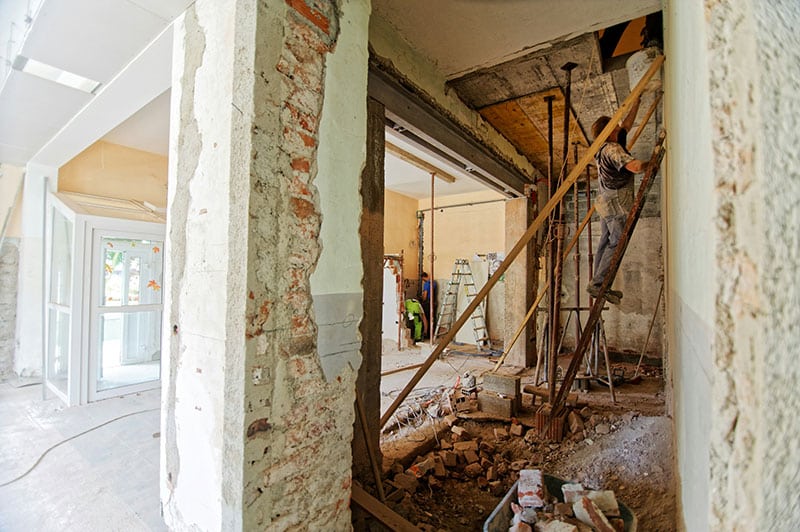What is the exposure limit for asbestos in the workplace?
The UK Health and Safety Executive (HSE) defines “exposure” as intake into the body by:
- Breathing dust, gas, fume, or mist
- Swallowing
- Skin contact
- Injection into the skin
In order to help protect workers’ health, the HSE approves workplace exposure limits (WELs) for hundreds of hazardous substances. Asbestos is regulated separately to this system; nonetheless, it is crucial for many employers to know the fibre exposure limits that currently apply to asbestos in an occupational setting in Great Britain.
Although the use of asbestos in UK construction was banned in 1999, this naturally occurring mineral is still present in potentially more than a million buildings across the UK. During its legal period of use, the substance was incorporated into roofing, cladding, ceiling coatings, lagging, and many more products.
For people who work in industries where asbestos is often present or suspected to be present – for example, where buildings dating from before the year 2000 are to be renovated or demolished – it is of critical importance to prevent or minimise any scope for asbestos exposure.
By ensuring your own adherence to the asbestos control limits in accordance with UK law, you will be greatly helping to protect worker health, in addition to shielding yourself from legal penalties and prosecution.
What are asbestos exposure limits?
Asbestos exposure limits are restrictions on the concentrations of asbestos fibres that workers can be legally subject to in a localised atmosphere, when they are carrying out tasks such as asbestos removal.
Certain forms of work, carried out in certain settings, can present a high risk of the given worker coming into contact with asbestos. Any disturbance of asbestos-containing materials (ACMs) as a consequence of such work could cause loose asbestos fibres to be released, and subsequently inhaled or ingested by someone nearby.
This, in turn, can bring about a much-increased risk of the exposed individual developing a potentially fatal asbestos-related disease – such as mesothelioma, asbestos-related lung cancer, or asbestosis – in later life.
Approximately 5,000 deaths a year in the UK are attributable to asbestos exposure, with many new diagnoses relating to incidents of exposure that occurred prior to the 1999 ban.
What is the current asbestos exposure limit in the workplace?
The asbestos exposure limit in the UK is not always the same. The following are the presently applicable fibre exposure limits in occupational settings in Great Britain:
- An exposure ‘control limit’ of 0.1 asbestos fibres per cubic centimetre (cm3) of air, averaged over a continuous four-hour period. This should not be considered a “safe” level, and employers should design their work activities to be as far below this limit as possible. Nonetheless, it is an important value for UK employers to be aware of. It helps them to determine, for example, whether particular work with ACMs needs to be done by an HSE-licensed professional, and whether employees will need to be provided with respiratory protective equipment (RPE).
- A ‘short-term exposure limit’ of 0.6 asbestos fibres per cm3 of air, measured over a 10-minute period. This is the threshold for determining whether exposure to asbestos fibres from work involving ACMs can be considered to be sporadic and of low intensity. Provided that work involving asbestos is with lower-risk materials such as asbestos cement products, is not expected to go above the aforementioned 0.1 fibres/cm3 control limit, and is not expected to exceed the 0.6 fibres/cm3 short-term exposure limit, there will not be a need for the contractor carrying out the work to be HSE-licensed.
- A clearance limit of 0.01 asbestos fibres per cm3 of air, following the completion of work involving ACMs and subsequent cleaning of the site. The employer should ensure that the concentration of asbestos fibres in the air at a given site is below this level before it can be handed back to the owner/occupier. HSE’s Code of Practice states that if this level is achieved, it should be regarded “as a transient indication of site cleanliness, in conjunction with the thorough visual inspection, and not as an acceptable, permanent environmental level.”
How are asbestos exposure limits determined?
The UK Government states that the present control limit for the concentration of asbestos fibres is “in accordance with the 1997 World Health Organization’s recommended method.” It has added that the HSE has “progressively tightened the control limit since 1987.”
There have recently been moves in continental Europe to tighten asbestos exposure limits; in October 2021, the European Parliament voted for a new asbestos occupational exposure limit of 0.001 f/cm3.
In April 2022, a Work and Pensions Committee report on the HSE’s approach to asbestos management urged the regulator to consider the application of such “more stringent” exposure limits in Europe to the context of Great Britain. The Committee added that the HSE “should ensure that the extent of the asbestos legacy in GB is not seen as reason to tolerate poorer health standards.”
In its response to that report, the HSE said that it would “review any robust, peer-reviewed evidence on exposure levels that show tangible health benefits for GB workers. Where there is evidence of a new workplace exposure limit being required, there will be a full consultation and cost-benefit analysis conducted as part of introducing any change.”
From the perspective of an employer seeking to ensure compliance with the rules, asbestos air testing can be used to determine airborne asbestos fibre concentrations. Forms of asbestos air monitoring such as leakage air testing directly outside of an asbestos enclosure, and personal air testing carried out on individuals, can help to ensure any control measures in place are adequate, and that the control limit has not been exceeded.
Why is it important to adhere to asbestos exposure limits?
As aforementioned, asbestos exposure can bring extremely serious health consequences. If the asbestos exposure limit is exceeded at a site where you are carrying out work with ACMs, your exposed workers could be at heightened risk of developing potentially fatal asbestos-related disease over the years and decades ahead. Adherence to the HSE-approved limits is therefore vital for creating and maintaining safe working environments.
It is also of critical importance for employers to be aware of the severe legal consequences that could await them if they fail to comply with the law.
Consider, for example, the case of this Warrington construction firm, which exposed the public to asbestos during renovation work, and was hit with a £90,000 fine. The well-known haulage firm Eddie Stobart is another to have previously been fined due to asbestos failures after builders came into contact with the substance at one of its sites; for this incident, a £133,000 fine was handed down.
How can workplaces monitor and control asbestos exposure?
There are various methods by which employers can assess and control the extent of exposure to asbestos that might occur in occupational settings. These encompass such interventions as asbestos air monitoring, the use of protective equipment, and engineering controls.
Asbestos air monitoring, for instance – also known as asbestos air testing – helps to prevent or reduce the spread of asbestos by measuring the background concentration of asbestos fibres while work with ACMs is taking place. It can be used to measure background fibre levels outside the enclosure to check for leaks, as well as inside the enclosure once the work is complete, to help ensure it has been thoroughly cleaned and dismantled.
Established best practices for minimising asbestos exposure, such as ensuring proper ventilation systems and the use of wet methods for any direct handling of asbestos, will further contribute to keeping concentrations of asbestos below the applicable limits.
What responsibilities do employers have regarding asbestos exposure limits?
The overarching asbestos legislation in the UK – the Control of Asbestos Regulations 2012 (CAR 2012) – makes clear, under Regulation 11, that employers must prevent employees from being exposed to asbestos. Alternatively, if this is not possible, the employer must implement the measures and controls necessary to reduce exposure to the lowest level reasonably practicable.
Present UK regulations make clear that employers are obliged to not only monitor asbestos levels in the atmosphere where work with ACMs is taking place, but also to inform workers about the presence of asbestos, and to take action to keep within the exposure limit.
Training is a mandatory requirement for anyone who is liable to be exposed to asbestos fibres at work. Further information on this is detailed under Regulation 10 of CAR 2012, which covers information, instruction, and training.
Asbestos awareness training, for example, must be provided to a broad range of individuals who carry out work within or on any building or structure that may contain asbestos. This encompasses – but is not limited to – such workers as construction and demolition workers, plumbers, electricians, gasfitters, joiners, plasterers, roofers, and general maintenance staff. Such training will help ensure workers are well-informed on asbestos health and safety risks.
What should workers do if they’re concerned about asbestos exposure?
If you come across asbestos unexpectedly during your work, you should immediately cease work, take steps to confirm whether the suspect substance is asbestos, and undertake a risk assessment.
You should also inform your employer, and raise any related concerns with them. If your employer is failing to implement appropriate controls, you can report your employer via the relevant enforcing authority, which may or may not be the HSE.
In the event that you are concerned about having potentially been exposed to asbestos, the HSE advises that you consult your GP and request that a note be made in your personal record about the possible exposure. This note should include information about the date(s), duration, type of exposure, and the likely levels of exposure (if this is known).
In some circumstances, your GP may refer you to a respiratory medicine specialist. However, it is important to realise that the HSE does not advocate routine x-rays for those who have been inadvertently exposed to asbestos. It takes years for asbestos-related damage to the lungs to develop and become visible on chest x-rays.
Conclusion: asbestos exposure limits play an integral role in protecting worker health
The asbestos exposure limits we have detailed in this article are very far from “optional extras”. Understanding and adhering to these limits is of critical importance for protecting the health of workers and ensuring the safest possible working environments.
Employers and workers have a shared responsibility when it comes to maintaining such standards, which makes ongoing education and vigilance crucial.
Are you on the lookout for expert asbestos services, such as asbestos surveying, air monitoring, and/or removal? If so, please feel free to email us or call the Oracle team for a fast and free quote.

Written by Jess Scott
Jess Scott has been an all-round asbestos consultant since 1996. That’s nearly 3 decades of asbestos knowledge. He spends his time sharing that knowledge with the team at Oracle and with their clients. Jess's goal is, and always has been, to use my expertise in helping people to comply with the law. This legal compliance ultimately helps to protect everyone from the harmful effects of asbestos. Jess has acted as an asbestos expert witness in legal cases and is involved in many asbestos educational activities throughout the UK.


